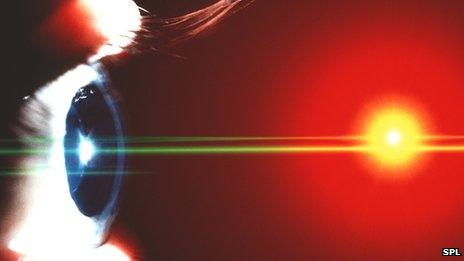Light-powered bionic eye invented to help restore sight
- Published

A retinal implant - or bionic eye - which is powered by light has been invented by scientists at Stanford University in California.
Implants currently used in patients need to be powered by a battery.
The new device, <link> <caption>described in the journal Nature Photonics</caption> <url href="http://www.nature.com/nphoton/journal/vaop/ncurrent/full/nphoton.2012.104.html" platform="highweb"/> </link> , uses a special pair of glasses to beam near infrared light into the eye.
This powers the implant and sends the information which could help a patient see.
Diseases such as age-related macular degeneration and retinal pigmentosa result in the death of cells which can detect light in the eye.
Eventually this leads to blindness.
Wiring eliminated
Retinal implants stimulate the nerves in the back of the eye, which has helped some patients to see.
Early results of a trial in the UK mean two men have gone from being totally blind <link> <caption>to being able to perceive light</caption> <url href="http://www.bbc.co.uk/news/health-17936302" platform="highweb"/> </link> and even some shapes.
However, as well as a fitting a chip behind the retina, a battery needs to be fitted behind the ear and a cable needs to join the two together.
Prof Robert MacLaren from Oxford Eye Hospital explains how the bionic eye implant works
The Stanford researchers say their method could be a step forward by "eliminating the need for complex electronics and wiring".
A retinal implant, which works in a similar way to a solar panel, is fitted in the back of the eye.
A pair of glasses fitted with a video camera records what is happening before a patient's eyes and fires beams of near infrared light on to the retinal chip.
This creates an electrical signal which is passed on to nerves.
Natural light is 1,000 times too weak to power the implant.
The researchers said: "Because the photovoltaic implant is thin and wireless, the surgical procedure is much simpler than in other retinal prosthetic approaches.
"Such a fully integrated wireless implant promises the restoration of useful vision to patients blinded by degenerative retinal diseases."
The implant has not been tested in people, but has been shown to work in rats.
Dr Keith Mathieson, now at the Institute of Photonics at the University of Strathclyde, was one of the lead researchers on the project. He said: "Age-related macular degeneration is a huge medical challenge and, with an aging population, is continuing to grow.
"This means that innovative, practical solutions are essential if sight is to be restored to people around the world with the condition.
"The implant is thin and wireless and so is easier to implant. Since it receives information on the visual scene through an infra-red beam projected through the eye, the device can take advantage of natural eye movements that play a crucial role in visual processing."
- Published12 March 2012
- Published3 May 2012
- Published3 November 2010